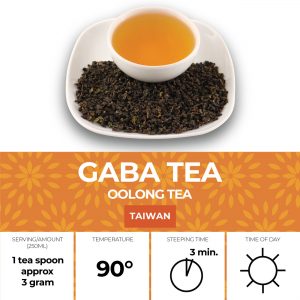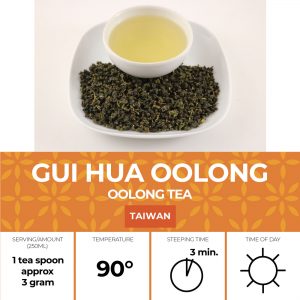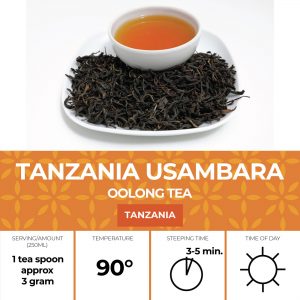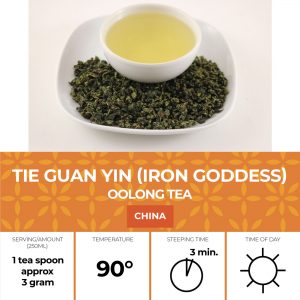Oolong is a traditional Chinese tea which finds its place between green and black teas produced through a process including withering the plant under strong sun and oxidation before curling and twisting. Most oolong teas, especially those of fine quality involve unique tea plant cultivars that are exclusively used for particular varieties.
Showing all 6 results

ALI MOUNTAIN
€30.90/100gPremium oolong comes from Ali Mountain Area. This tea is classic example of excellent oolong. This tea is grown at an altitude of 700-1300 meters above sea level. The taste is sweet, smooth with undertones of fruit. Simply beautiful experience for every tea lover!
THE LEAVES MAY BE STEEPED MULTIPLE TIMES

GABA TEA
€25.50/100gThis organic oolong tea boasts small, tigthly rolled chocolate-colored leaves with a slight reddish hue. Its infusion hints at tart plums with a smooth, light and slightly dry mouth feel that has a woody-sweet quality.
THE LEAVES MAY BE STEEPED MULTIPLE TIMES

GUI HUA
€16.50/100gThis tea was especially popular among the ladies in the past as they believe that drinking it can help them enhance their beauty. In any case, Gui Hua Oolong is truly a lovely tea suitable to be shared with your friends and family anytime.
THE LEAVES MAY BE STEEPED MULTIPLE TIMES

ORIENTAL BEAUTY
€16.50/100gA Dark Oolong marketed as White Tip Oolong or Champagne Oolong, is a heavily oxidized, non-roasted, tip-type oolong tea produced in Hsinchu County, Taiwan.
THE LEAVES MAY BE STEEPED MULTIPLE TIMES

TANZANIA USAMBARA – 100 gram
€15.00/100gTanzania is a country in East Africa in the African Great Lakes region. Tea settlers were founded by German settlers in 1902. Up to half of the tea production is provided by small local farmers. This is where our tea specialty comes from. From the slope of Mount Kilimanjaro. Very beautiful textured brown leaves, nice tips. Delicate aromatic mild nutty taste.

TIE GUAN YIN – IRON GODDESS
€10.50/100gSometimes also written as Ti Kuan Yin or Iron Goddess Oolong Tea. Apart from its amazing taste, this tea also has great health benefits, being high in amino acids, vitamins and antioxidants. Tie Guan Yin tea is a slightly fermented tea, that sits between highly fermented black teas and unfermented green and white teas.
THE LEAVES MAY BE STEEPED MULTIPLE TIMES
